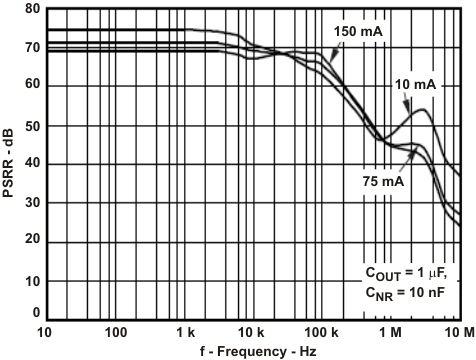SLAA414A July 2009 – August 2017 LFC789D25 , LM1086 , LM1086-MIL , LM1117 , LM237 , LM317 , LM317L , LM317L-N , LM317M , LM317MQ , LM337 , LMS1585A , LMS1587 , LP2950 , LP2951 , LP2981 , LP2981A , LP2985 , MC79L , REG101 , REG102 , REG103 , REG104 , REG1117 , REG1117A , REG1118 , REG113 , SM72238 , SN105125 , TL1963A , TL317 , TL5209 , TL720M05-Q1 , TL750L , TL750M , TL750M-Q1 , TL751L , TL760M33-Q1 , TL780 , TL783 , TLE4275-Q1 , TLV1117 , TLV1117LV , TLV700-Q1 , TLV70012-Q1 , TPPM0110 , TPPM0111 , TPPM0301 , TPPM0302 , TPPM0303 , TPS51100 , TPS51103 , TPS51200 , TPS61100 , TPS61107 , TPS61120 , TPS61121 , TPS61122 , TPS65020 , TPS65021 , TPS65022 , TPS650231 , TPS65023B , TPS65050 , TPS657052 , TPS65708 , TPS657095 , TPS701 , TPS70175-Q1 , TPS702 , TPS703 , TPS70345-EP , TPS704 , TPS707 , TPS70751-EP , TPS708 , TPS71 , TPS71025 , TPS712 , TPS71202-EP , TPS713 , TPS715 , TPS715-Q1 , TPS71501-EP , TPS715A , TPS715A-NM , TPS718 , TPS719 , TPS71H01 , TPS72 , TPS720 , TPS721 , TPS72118-EP , TPS722 , TPS723 , TPS725 , TPS726 , TPS727 , TPS728 , TPS73 , TPS730 , TPS731 , TPS73101-EP , TPS731125-EP , TPS73115-EP , TPS73118-EP , TPS73125-EP , TPS73130-EP , TPS73132-EP , TPS73133-EP , TPS73150-EP , TPS732 , TPS732-Q1 , TPS73201-EP , TPS73215-EP , TPS73216-EP , TPS73218-EP , TPS73225-EP , TPS73230-EP , TPS73233-EP , TPS73250-EP , TPS734 , TPS735 , TPS736 , TPS73601-EP , TPS73615-EP , TPS73618-EP , TPS73625-EP , TPS73630-EP , TPS73632-EP , TPS73633-EP , TPS737 , TPS737-Q1 , TPS73HD3 , TPS74 , TPS74201 , TPS74301 , TPS74401 , TPS74701 , TPS74801 , TPS74901 , TPS751 , TPS75103 , TPS75105 , TPS75125-EP , TPS752 , TPS752-Q1 , TPS75201-EP , TPS75201M-EP , TPS75215-EP , TPS75218-EP , TPS75225-EP , TPS75233-EP , TPS753 , TPS75301-EP , TPS75318-EP , TPS75325-EP , TPS75333-EP , TPS754 , TPS755 , TPS756 , TPS757 , TPS758 , TPS759 , TPS760 , TPS76201 , TPS763-Q1 , TPS766 , TPS767 , TPS767-Q1 , TPS76701-EP , TPS76715-EP , TPS76718-EP , TPS76725-EP , TPS76733-EP , TPS767D3 , TPS767D3-Q1 , TPS767D301-EP , TPS768 , TPS768-Q1 , TPS76801-EP , TPS76815-EP , TPS76818-EP , TPS76825-EP , TPS76833-EP , TPS76850-EP , TPS769 , TPS769-Q1 , TPS76901-HT , TPS770 , TPS77101-Q1 , TPS773 , TPS774 , TPS77401-EP , TPS775 , TPS775-Q1 , TPS77501-EP , TPS77515-EP , TPS77518-EP , TPS77525-EP , TPS77533-EP , TPS776 , TPS776-Q1 , TPS77601-EP , TPS77615-EP , TPS77618-EP , TPS77625-EP , TPS77633-EP , TPS777 , TPS778 , TPS779 , TPS780 , TPS781 , TPS782 , TPS786 , TPS789 , TPS790 , TPS791-Q1 , TPS79101-EP , TPS79133-EP , TPS79147-EP , TPS793-Q1 , TPS79301-EP , TPS79318-EP , TPS79333-EP , TPS793475-EP , TPS794 , TPS797 , TPS797-Q1 , TPS79718-EP , TPS79730-EP , TPS799 , TPS799-Q1 , TPS7A45 , UA723 , UA78 , UA78L , UA78M , UA78M-Q1 , UA79 , UA79M , UC1832 , UC1832-SP , UC1834 , UC1834-SP , UC1836 , UC282 , UC2832 , UC2832-EP , UC2833 , UC2834 , UC2834M , UC2835 , UC2836 , UC285 , UC382 , UC3832 , UC3833 , UC3834 , UC3836 , UC385 , UCC281 , UCC283 , UCC2837 , UCC284 , UCC381 , UCC383 , UCC384
1 What is PSRR?
Power Supply Rejection Ratio or Power Supply Ripple Rejection (PSRR) is a measure of a circuit’s power supply’s rejection expressed as a log ratio of output noise to input noise. PSRR provides a measure of how well a circuit rejects ripple, of various frequencies, injected at its input. The ripple can be either from the input supply such as a 50Hz/60Hz supply ripple, switching ripple from a DC/DC converter, or ripple due to the sharing of an input supply between different circuit blocks on the board. In the case of LDOs, PSRR is a measure of the regulated output voltage ripple compared to the input voltage ripple over a wide frequency range (10Hz to 1MHz is common) and is expressed in decibels (dB). The PSRR is very critical parameter in many audio and RF applications.
The basic equation for PSRR is:

Historically LDOs have poor high frequency PSRR performance, but currently TI has LDOs with PSRR > 40dB at 5MHz. One important point regarding the PSRR graphs in TI LDO datasheet is that the PSRR axis is inverted (See Figure 1). The PSRR is calculated as rejection so it should be a negative number; however, the graph shows it as positive number so that a higher number denotes higher noise rejection.
 Figure 1. PSRR Graph of TPS717xx LDOs
Figure 1. PSRR Graph of TPS717xx LDOs